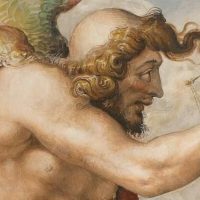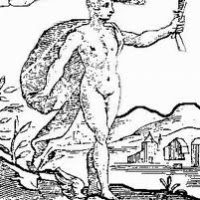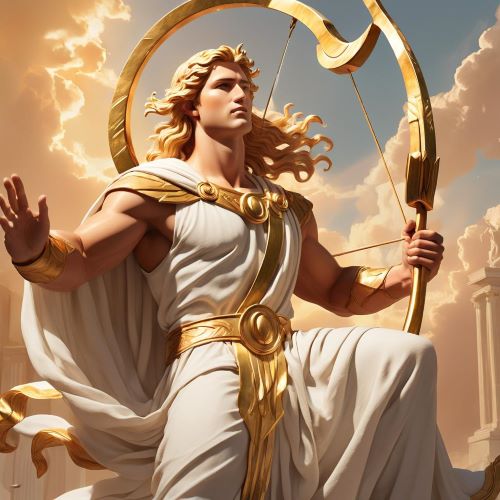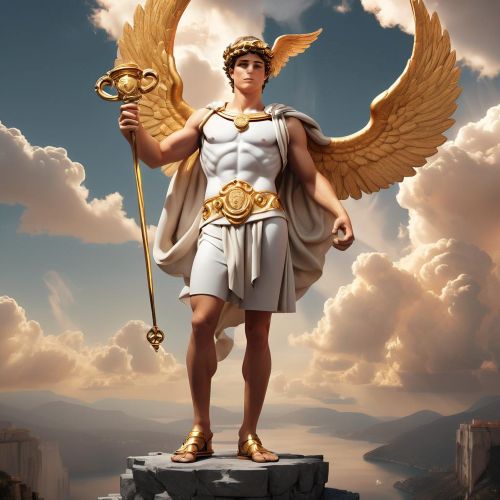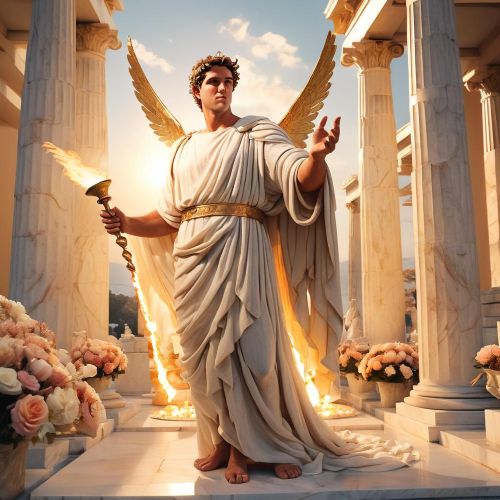Caerus : God of Opportunity
Listen
At a glance
| Description | |
|---|---|
| Origin | Greek Mythology |
| Classification | Gods |
| Family Members | Zeus (Father) |
| Region | Greece |
| Associated With | Opportunity, Fleeting Chances |
Caerus
Introduction
In the rich landscape of Greek mythology, Caerus (Greek: Καιρός, also known as Kairos) holds a unique and philosophical place as the personification of opportunity, luck, and the opportune moment. While Chronos symbolizes the linear passage of time, Caerus embodies a more subtle concept: the right time, the fleeting instant when decisive action can change everything. He is often described as the youngest son of Zeus, and unlike the gods who rule with power or dominion, Caerus governs something intangible yet essential—the chance that appears suddenly and must be seized before it disappears. His presence in myth is less about elaborate stories and more about a guiding principle, shaping how the Greeks understood timing, fate, and the balance between preparation and chance.
Physical Traits
The artistic and literary depictions of Caerus emphasize his elusive nature. Ancient descriptions portray him as a youthful, athletic figure in constant motion, embodying agility and swiftness. He often balances on the tips of his toes or is shown running, suggesting how quickly opportunities arise and vanish. His most famous attribute is his unusual hairstyle: a single lock of hair falling over his forehead, while the back of his head is completely bald. This striking symbolism illustrates that he can only be caught while approaching—if allowed to pass, there is nothing to grasp.
Some ancient representations add wings to his feet, reminiscent of Hermes, to symbolize speed and transience. In works of art, he sometimes carries a razor, symbolizing the sharpness of decisive action, or scales balanced precariously, representing the delicate equilibrium of chance. The statue of Caerus created by the sculptor Lysippos at Sicyon was a celebrated depiction of this imagery, offering a visual reminder of the fleeting nature of opportunity.
Family
Caerus’s genealogical placement within Greek mythology is less established than that of major Olympian gods. Classical writers often describe him as the youngest child of Zeus, linking him directly to the king of the gods and emphasizing his divine authority over time’s most critical moments. Unlike his brother Chronos, who governs time’s relentless flow, Caerus focuses on particular instances, moments that can alter destiny.
Some accounts connect him with Tyche, the goddess of fortune, who in Roman mythology is called Fortuna. Their association highlights the intertwining of chance and opportunity—Tyche offering fortune and Caerus providing the precise moment to act. Together, they reflect the Greek belief that both fate and timing must align for success or prosperity. These familial and thematic relationships situate Caerus within a larger framework of deities concerned with fate, luck, and the rhythm of human life.
Other Names
The most widely used alternative name for Caerus is Kairos, which translates directly to “the right time” or “opportune moment” in Greek. This term continues to resonate in philosophical, rhetorical, and theological traditions. In Roman mythology, he appears under the names Occasio or Tempus, reflecting the cultural adaptation of his role. While Tyche and Fortuna embodied broader concepts of chance or luck, Caerus was always tied to decisive timing.
One of his epithets, “Pandamator” (“the subduer of all”), points to the idea that even the mightiest can be undone if they fail to act at the right moment. Unlike gods who were worshipped through temples and rituals, Caerus existed more as a philosophical construct. His name became a cornerstone in discussions about decision-making, ethics, and divine timing.
Powers and Abilities
Caerus does not wield weapons or command armies like many Olympians, but his influence is no less profound. His power lies in governing fleeting windows of opportunity. He embodies the moment where preparation and chance intersect, allowing success, transformation, or even survival. He does not dictate outcomes but rather presents the conditions for decisive action. Those who are aware, wise, or courageous enough to seize him achieve their aims; those who hesitate miss their chance.
In Greek thought, this principle extended into many disciplines. In rhetoric, kairos meant the right time to deliver a persuasive speech. In medicine, it referred to the critical moment for diagnosis or treatment. In warfare, it was the instant when striking would bring victory. Caerus thus became a divine metaphor for awareness, adaptability, and the importance of timing in every sphere of human life.
Modern Day Influences
The legacy of Caerus extends well beyond ancient Greece. The concept of kairos remains influential in modern philosophy, theology, communication studies, and leadership theory. In Christian theology, kairos is often understood as God’s appointed time, a sacred moment of transformation. In rhetoric and literature, it denotes the ideal moment to speak or act for maximum impact.
In contemporary culture, Caerus’s symbolism resonates in fields as varied as business strategy, sports, and innovation. Entrepreneurs often describe “market timing” as the decisive factor for success, echoing Caerus’s ancient message that recognizing the right moment is as important as skill or preparation. In motivational writing and self-help contexts, his imagery is invoked to inspire people to act before opportunities vanish.
Technology and science have also borrowed his name. Research projects, mobile systems, and even routers have been named CAERUS, reflecting his enduring association with precision and timely execution. Meanwhile, artists and scholars continue to reference the Lysippos statue, using it as a reminder of the human struggle to recognize and act upon fleeting opportunities.
Ultimately, Caerus represents more than a mythological figure—he embodies a principle that continues to shape human understanding of success, chance, and decisive action. From the bustling marketplaces of Athens to modern boardrooms and classrooms, his lesson endures: opportunity is brief, and only those who grasp it at the right moment will harness its power.
Related Images
Source
Graf, F. (1993). Greek Mythology: An Introduction. Johns Hopkins University Press.
Mikalson, J. D. (2010). Ancient Greek Religion (2nd ed.). Wiley-Blackwell.
Plato. (360 BCE/1997). The Dialogues of Plato (B. Jowett, Trans.). Oxford University Press.
Beard, M., North, J., & Price, S. (1998). Religions of Rome: Volume 1, A History. Cambridge University Press.
Burkert, W. (1985). Greek Religion: Archaic and Classical. Harvard University Press.
“Kairos.” (n.d.). Theoi Greek Mythology. Retrieved 28 September 2025, from https://www.theoi.com/Protogenos/Kairos.html
“Caerus: Deity of Opportunity.” (2024). Mythopedia. Retrieved 28 September 2025, from https://mythopedia.com/topics/caerus
Stavrou, T. (2016). “Kairos and Leadership in Ancient Greece.” Leadership Quarterly, 27(2), 181-195.
Wikipedia contributors. (2025, September 27). Caerus. Wikipedia. https://en.wikipedia.org/wiki/Caerus
GreekMythology.com. (n.d.). Caerus. https://www.greekmythology.com/Other_Gods/Minor_Gods/Caerus/caerus.html
Ancient Literature. (2022, August 16). Caerus: The God of Opportunity. https://ancient-literature.com/caerus/
Kinneavy, J. L., & Eskin, C. R. (1994). Kairos in classical and modern rhetorical theory. Rhetoric Review, 13(1), 13–22. https://doi.org/10.1080/07350199409359145
Pausanias. (1918). Description of Greece (W.H.S. Jones, Trans.). Loeb Classical Library.
Fairbanks, A. (Trans.). (1931). Descriptions (Ekphráseis) by Callistratus. Harvard University Press.
Chantraine, P. (1968). Dictionnaire étymologique de la langue grecque. Klincksieck.
Ion of Chios. (ca. 490–425 BCE). Fragments and Hymns. In M.L. West (Ed.), Greek Lyric Poetry. Oxford University Press.
Frequently Asked Questions
What is lorem Ipsum?
I am text block. Click edit button to change this text. Lorem ipsum dolor sit amet, consectetur adipiscing elit. Ut elit tellus, luctus nec ullamcorper mattis, pulvinar dapibus leo.
What is lorem Ipsum?
I am text block. Click edit button to change this text. Lorem ipsum dolor sit amet, consectetur adipiscing elit. Ut elit tellus, luctus nec ullamcorper mattis, pulvinar dapibus leo.
What is lorem Ipsum?
I am text block. Click edit button to change this text. Lorem ipsum dolor sit amet, consectetur adipiscing elit. Ut elit tellus, luctus nec ullamcorper mattis, pulvinar dapibus leo.
What is lorem Ipsum?
I am text block. Click edit button to change this text. Lorem ipsum dolor sit amet, consectetur adipiscing elit. Ut elit tellus, luctus nec ullamcorper mattis, pulvinar dapibus leo.
What is lorem Ipsum?
I am text block. Click edit button to change this text. Lorem ipsum dolor sit amet, consectetur adipiscing elit. Ut elit tellus, luctus nec ullamcorper mattis, pulvinar dapibus leo.




